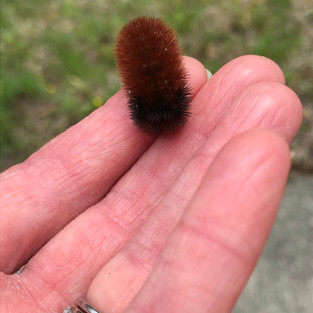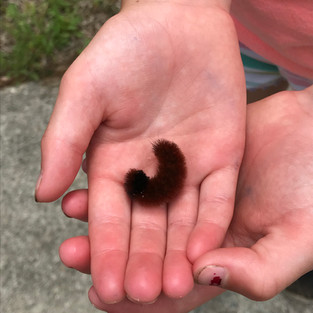Good Morning Watershed Explorers,
This is a recycled post that I wrote back in May! Since so many of you were not Watershed Explorers at that time, I chose to share it again. This is one of my absolute favorite critters. I cherished these little beauties as a child and loved finding them when raking up leaves with my parents in the fall. In honor of the hours of leaf raking that I completed with my children yesterday, I decided to share this post a second time. This is a fantastic time of year to get outside. You can make a huge leaf pile to jump in, and you just may be lucky enough to find Pyrrharctia isabella! I wish you a magnificent Sunday my amazing Watershed Explorer scientists. Please send your stories and explorations my way! I would love to hear from you!
The critter spotlight for this week is the banded woolly bear caterpillar. The banded woolly bear becomes the Isabella tiger moth. The moth is beautiful, but I have a soft spot in my heart for the cute, little, furry caterpillar. These docile little creatures look like little furballs. Upon picking them up, similar to pillbugs, they will often curl up into a tight ball. Here are a few pictures of the banded woolly bear, and one of the adult moth!
The woolly bear caterpillar used to be considered a weather predictor. Entomologists (scientists who study insects) have since found this to be untrue, but folklore said that if the banded woolly had a large orange band that winter would be mild and if the band was small the winter would be harsh. There are also those that believe that if the caterpillar has two large black bands at the beginning of the body and then at the end that the beginning and end of the winter will be harsh, but the middle will be mild. Whether a weather predictor or not, it is still rather incredible that this little creature can have so many variations of color. In the pictures above, the curled up woolly is entirely black, while the other has a small black band while the rest is dark orange.
Habitat:
Banded woolly bear caterpillars and Isabella tiger moth adults are found near marshes, meadows, and forests. The caterpillars like moisture and extensive ground debris where they can hide.
Diet:
Isabella tiger moths feed on nectar from wildflowers. Their mouthparts are similar to a straw.
Banded woolly bear caterpillars have chewing mouthparts and will eat dandelions, clover, birch leaves, maple leaves, and other grasses.
Watershed Role:
As you can probably tell, woolly bears are not water creatures. However, they still play an important role in the watershed food chain as they provide food for other creatures.
I am not one to promote keeping wild critters as pets, but many people do raise woolly bear caterpillars into moths. Woolly bears are actually one species of caterpillar that hibernates. Here is a brochure that explains how to raise a woolly bear. The life cycle on the brochure is great. https://www.cambridgebutterfly.com/wpcontent/uploads/2017/12/woolly_bear_brochure.pdf
I hope you enjoyed learning about the banded woolly bear. If you have an idea for a future critter spotlight, please go to the www.nbcwatershedexplorers.com webpage and email me from the green button at the bottom of any of the pages with your ideas!
Much love Watershed Explorers,
Mrs. Morissette













Comments